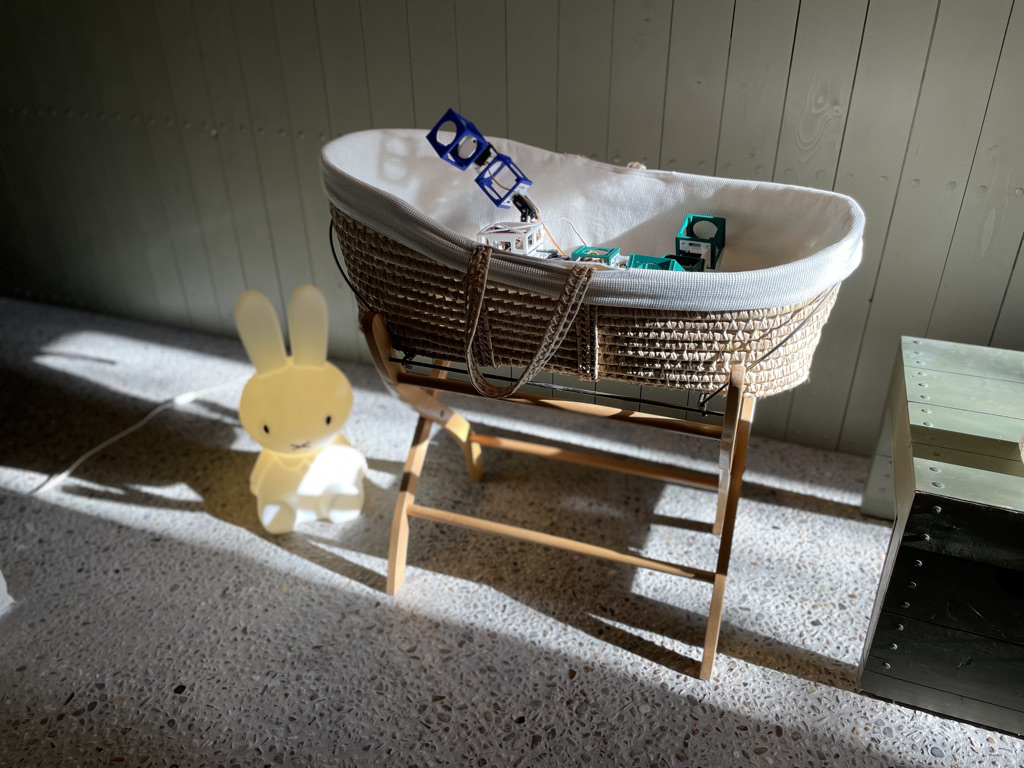Blog Posts
Event Report: Neo the Robot Baby
Soyun Jang

Neo in his nursery, Buitenplaats Doornburgh
Neo the robot baby was born on 15 October 2021 at Vrije Universiteit Amsterdam. He was transported afterwards to Buitenplaats Doornburg, Maarsen, to be displayed at Bram Ellens’ exhibition, Robots in Captivity.
Neo is a copy of a robot baby developed by Agoston E. Eiben (professor of computational intelligence at VU) and his research team. Leader of Computational Intelligence Group, his field of research is artificial intelligence based on evolutionary computing. Eiben’s project consists of two parent robots (Spider and Gecko) that mate and exchange genomes via Wi-Fi. The result is a robot baby that exists in physical form (first created in 2016) which Neo is a copy of.
See here for a video for an introduction of Eiben’s Robot Baby project:
In Ellens’ exhibition, each robot displayed has its own backstory, such as what they were designed to do, where they come from, and why they are kept in captivity. Following is Ellen’s introduction of Neo.
NEO
Case number:
N_3_0
Case description:
Neo was left as a foundling in front of the door of Buitenplaats Doornburgh. His/her (the gender is still unclear at the moment) parents were not able to give Neo the love needed to thrive in this world. The kennel did not hesitate a single moment and took over the parental responsibilities until a suitable foster-home is found.
Species:
Rubik cubus
Dimensions:
43cm, Weight 1353gr
Natural habitat:
All elements of this species are born in captivity. Can be found in research centres, some are smuggled out to function as pet in student-homes.
Peculiarities:
This robot, Neo, is a genetically identical “twin” of world’s first robot baby born in 2016 at the Vrije Universiteit Amsterdam. The parents of the robot baby were two handmade robots, the Spider and the Gecko. They met in the lab, mixed their genetic material via Wi-Fi, and had their child built based on a 3D- printer, prefabricated “organs”, and skillful human hands. The project was a scientific proof-of-concept to demonstrate that robot reproduction -and hence robot evolution- is possible. More information on https://evosphere.eu/
Neo’s endearing presence affords the audience to imagine the exhibition space as a world where robots are completely integrated to our society, procreating without the help of humans. Robots such as Josephine who dances on the streets for money, and Bassie who works as a caregiver will not be made but born, carrying the genomes of their parents. On the contrary to these harmless entities, there will also be destructive robots such as The Mad King. This leads to the question of our coexistence with robots in our present and future.
In other words, Neo plays two roles in this exhibition. First, he creates a dramatic effect throughout the exhibition. He transforms the space from being simply filled by individual robots to a space in which they coexist with humans as a part of our human-robot society. Next, through this transformation, he questions what it means for us to coexist with being that have come to existence as result of evolving technology. How are their births controlled – or not controlled – by humans? To what extent do we anthropomorphize them, and how does that affect our relation to and relationship with robots? How can/do we coexist?
See here for more photos and videos of Neo.

